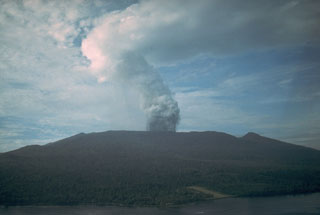Report on Karkar (Papua New Guinea) — September 1997
Bulletin of the Global Volcanism Network, vol. 22, no. 9 (September 1997)
Managing Editor: Richard Wunderman.
Karkar (Papua New Guinea) Fumarolic gas kills downwind vegetation
Please cite this report as:
Global Volcanism Program, 1997. Report on Karkar (Papua New Guinea) (Wunderman, R., ed.). Bulletin of the Global Volcanism Network, 22:9. Smithsonian Institution. https://doi.org/10.5479/si.GVP.BGVN199709-251030
Karkar
Papua New Guinea
4.647°S, 145.976°E; summit elev. 1839 m
All times are local (unless otherwise noted)
At the end of September, two level lines and a drytilt array re-established on the floor of the inner caldera of Karkar and two restored drytilt sites at different altitudes on the western flank of the island indicated that no significant deformation had taken place since November 1993.
A small fumarole on the SE of the summit of Bagiai Cone near the rim of the head wall of the 1979 explosion pit has caused vegetation to die in a well-defined downwind swath to the W.
Geological Summary. Karkar is a 19 x 25 km forest-covered island that is truncated by two nested summit calderas. The 5.5 km outer caldera was formed during one or more eruptions, the last of which occurred 9,000 years ago. The steep-walled 300-m-deep, 3.2 km diameter, inner caldera was formed sometime between 1,500 and 800 years ago. Cones are present on the N and S flanks of this basaltic-to-andesitic volcano; a linear array of small cones extends from the northern rim of the outer caldera nearly to the coast. Recorded eruptions date back to 1643 from Bagiai, a pyroclastic cone constructed within the inner caldera, the floor of which is covered by young, mostly unvegetated andesitic lava flows.
Information Contacts: B. Talai and H. Patia, Rabaul Volcano Observatory (RVO), P.O. Box 386, Rabaul, Papua New Guinea.

